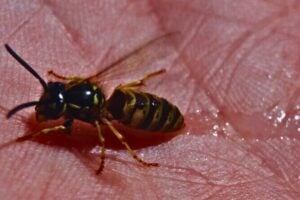A bee sting itch usually lasts a few hours to two days, depending on skin sensitivity and treatment. The discomfort comes from the body’s histamine response to venom, causing redness and irritation.
About 10% of people react more strongly, but most find relief with simple steps. Applying a cold compress, using antihistamine cream, or trying home remedies like aloe vera can help. Avoiding scratching prevents worse irritation. Those curious about longer-term solutions will discover practical tips ahead.
Itch From a Bee Sting
The itch from a bee sting can feel relentless, almost like an annoying whisper under the skin that won’t fade. This discomfort stems from the body’s histamine response, a natural reaction to the venom.
At the time a bee stings, it injects venom that triggers an inflammatory reaction, causing redness, swelling, and that maddening itch. Histamine, released by immune cells, signals nerves in the skin, making the area feel irritated. About 10% of people experience stronger reactions, but for most, the itch is temporary.
Understanding this process helps in managing the symptoms. The body’s defense system works hard to neutralize the venom, which is why the itch lingers.
Cold compresses or antihistamines can ease the discomfort by calming the histamine response. Recognizing the cause reassures those assisting others, as they can explain why the itch happens and how to soothe it effectively. Patience and care make the healing process smoother for anyone coping with a sting.
Typical Duration of Bee Sting Itch
Factors like skin sensitivity or numerous stings could prolong the timeline. Scratching can exacerbate irritation, so gentle care is pivotal.
While the itch feels unending, it’s transient—focusing on soothing methods assists in managing the wait. Transitioning to immediate relief steps can alleviate discomfort, but awareness of this standard timeframe readies caregivers to support others patiently.
Maintaining composure and knowledge guarantees improved care for those enduring the sting’s lingering effects.
Immediate Steps to Reduce Itching
Why does a bee sting itch so much right after it happens? The venom triggers histamine release, causing inflammation and itching. Acting quickly can minimize discomfort.
| Step | Purpose |
|---|---|
| Cold compress application | Reduces swelling and numbs the area |
| Topical antihistamine use | Blocks histamine to ease itching |
| Avoid scratching | Prevents infection and worse irritation |
| Clean the sting site | Lowers risk of bacterial infection |
Applying a cold compress for 10–15 minutes slows venom spread and soothes the skin. Over-the-counter topical antihistamines, like hydrocortisone cream, target itch receptors. Gently washing the area with soap and water prevents complications. These steps offer quick relief while preparing for longer-term care when needed.
Home Remedies for Bee Sting Itch Relief
As soon as a bee sting begins itching, simple home remedies can provide prompt relief without visiting the pharmacy. These natural solutions are gentle, effective, and easy to find at home, making them ideal for quick comfort.
- Cooling aloe vera gel soothes inflamed skin, reducing itchiness and promoting healing.
- A paste of baking soda and water neutralizes venom and calms irritation.
- Honey, applied lightly, offers antibacterial properties while easing discomfort.
- Soothing essential oils like lavender or tea tree, diluted with a carrier oil, reduce swelling and itch.
- A cold compress numbs the area, providing immediate relief from itching.
These remedies work best as soon as the sting occurs. Around 10% of people experience prolonged itching, but most find relief within hours using these methods. Always clean the sting site first to prevent infection. For those helping others, these options offer a comforting, natural approach to easing discomfort quickly.
Over-the-Counter Treatments for Itch Relief
Many people find quick relief from bee sting itch with over-the-counter treatments, which offer stronger solutions as home remedies aren’t sufficient. Antihistamine creams, like diphenhydramine-based gels, block histamine reactions, reducing swelling and itchiness within minutes. Studies show these creams improve symptoms for 70% of users within an hour.
Corticosteroid lotions, such as hydrocortisone, calm inflammation and are especially helpful for persistent itching. Applying them twice daily can accelerate healing. Oral antihistamines, like Benadryl, also ease discomfort but could cause drowsiness—useful for nighttime relief.
For those helping others, keeping these options on hand guarantees prompt care. Always follow label instructions and avoid overuse, as prolonged steroid application might thin the skin. Should redness worsen, discontinue use. These treatments provide reliable comfort, allowing individuals to focus on recovery without distraction.
When to Seek Medical Attention for Bee Sting Itch
While most bee stings cause mild irritation, certain signs demand immediate medical care to prevent serious complications. Recognizing when to seek help can protect those experiencing severe reactions.
- Allergic reactions: Difficulty breathing, hives, or dizziness signal anaphylaxis, requiring emergency care.
- Severe swelling: If swelling spreads beyond the sting site (like to the face or throat), it’s dangerous.
- Multiple stings: More than 10 stings increase toxin exposure, heightening risks.
- Persistent symptoms: Itch or pain lasting over a week may indicate infection.
- Unusual fatigue: Feeling weak or confused after a sting suggests a systemic reaction.
About 5–7% of people experience allergic reactions to stings, and severe swelling affects roughly 3%. Quick action saves lives, so don’t hesitate to call for help if these symptoms appear. Staying alert guarantees safety for those vulnerable to stronger reactions.



